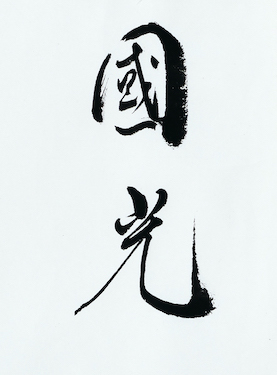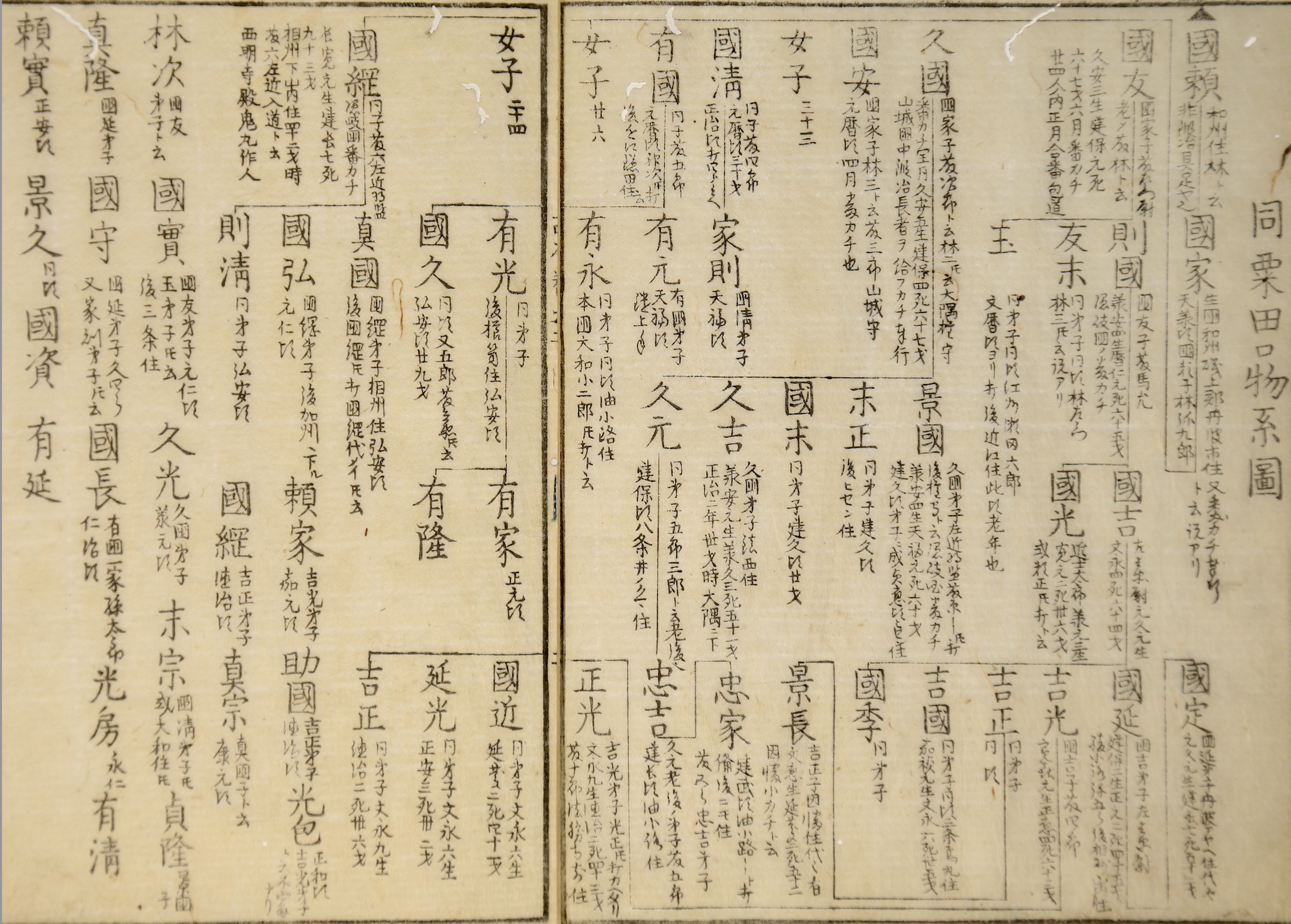
Awataguchi (粟田口) is one of the seven gates to Kyōto city in Yamashiro (山城) province. The school takes its name from this gate as no doubt they were located nearby. They served the Imperial Court which was resident in Kyōto, and the Awataguchi smiths have been hailed for centuries as some of the brightest lights in the world of Japanese swords. Their work represents the very top level of craftsmanship.
The roots of Awataguchi are a bit misty but it takes its place after Sanjō (三条) and Gojō (五条) schools of the end of the Heian (平安, 794-1185) period and begins somewhere around the middle to late 1100s, likely concurrent with Ayanokōji (綾小路). Awataguchi seems to have been famous already in its time, as there is a 13th century book called the Ujijui-monogatari which mentions this school of smiths.
The founder is Kuniie (国家), who belonged to the Fujiwara clan (藤原氏) and had the family name Hayashi (林). He would have six sons, each of which would achieve great heights in the craft of sword making. They are Kunitomo (国友), Hisakuni (久国), Kuniyasu (国安), Kunikiyo (国清), Arikuni (有国) and Kunitsuna (国綱) (six Awataguchi brothers). Kunitomo represents the main line, having handed the school down to his son Norikuni, grandsons Kuniyoshi and Kunimitsu, and great grandson the very famous Yoshimitsu.
Awataguchi Kunimitsu (粟田口国光), first name Tarō (太郎), was the second son of Awataguchi Norikuni (粟田口則国) and as his older brother, Kuniyoshi (国吉), he borne the honorary title Sahyōe no Jō (左兵衛尉). Another alternative version proposes a very interesting assumption: that Awataguchi Kunimitsu’s grandfather could have been a smith of the Yamato Taima School, although the generally accepted line of this branch is Kunitomo (国友)---Norikuni (則国)---Kunimitsu (国光). Many modern researchers believe that it was Awataguchi Kunimitsu who was the father and teacher of Shintōgo Kunimitsu (新藤五国光), that is rightfully considered the founder of the Sōshū School. They have tried to explain the name Hasebe, which Shintōgo sometimes used. The name Hasebe comes from the name of an area located only twenty kilometers from Nara (Yamato). This is a unique explanation for one of the strangest phenomena that we see: the appearance of the name “Hasebe” near the name “Shintōgo” in some signatures.
The work of Awataguchi Sahyōe no Jō Kunimitsu is extremely rare. There are a handful of unsigned swords attributed to him in the NBTHK Juyo index, along with one tanto dated 1321 signed Kunimitsu with the NBTHK notation that this is a work of the second generation working in Awataguchi. There are no other signed works either Shodai or Nidai listed in the index. We know of the Shodai Kunimitsu from two signed tachi that exist that are Juyo Bunkazai and a single signed ken. There are no other signed works, and none of these other three are dated. This leads to some difficulty in placing his work period and of course in establishing theories in regards to Shintōgo Kunimitsu. Fujishiro does place Kunimitsu in Shōō (正応, 1288-1293) and places Shintōgo around 1312.
According to the Kotō Meizukushi Taizen (古刀銘盡大全), published in 1792, Awataguchi Kunimitsu was born in the 2d year of the Ken ́ei era (建永, 1207) and died at the age of thirty-six in the 2d year of the Kangen era (寛元, 1244). Kunimitsu is listed in this manuscript with the first name Tarō (太郎) and with the rank of a shinshi (進⼠), a person that passed certain tests of the Imperial school of civil servants during the Ritsuryō era.

Figure 1. Genealogy of the Awataguchi School's masters. Kotō Meizukushi Taizen, 1792, vol. 2, p. 1/2 and 2/1.
The Kotō Meizukushi Taizen (古刀銘盡大全) and Kokon Meizukushi Taizen (古今銘尽大全) lists Kunimitsu next to Kuniyoshi as a direct line from Norikuni in order accepted to indicate father and son relationship. We don’t know for sure how many smiths borne Kunimitsu’s name have been active within the Awataguchi school and what theirs exact relations were within the lineage. There are a lot of references connecting Awataguchi Kunimitsu to Kenmu era (建武, 1334-1338). Supposedly, Tarō Kunimitsu was Norikuni’s second son but had his own son Tōbei. This would have been possible if Tōbei continued the line of Awataguchi Tarō Kunimitsu as the second generation. The NBTHK Juyo Token #26 could be regarded as kind of proof of Kunimitsu’s second generation existence. This sword is dated “the 10th month of the 3d year of Genkō era (元享, 1321-1324)” and was attributed by NBTHK as shodai Awataguchi Kunimitsu.
Figure 2. Kokon Meizukushi Taizen by Takeya, 1661, vol. 1, p. 2/1.
Summing up all of the above-mentioned information, Awataguchi Kunimitsu’s genealogy should be interpreted somewhat differently than the way he was presented by ancient and some modern specialists:
Predecessor’s generation
Awataguchi Kunimitsu, son of Norikuni, Tarō, Sahyōe no Jō
Activity: Jōei (貞永, 1232-1233) - Kenchō (建長, 1249-1256)
|
1st generation
Awataguchi Kunimitsu, Tōbei
Activity: Kōan (弘安, 1278-1288) - Shōō (正応, 1288-1293)
|
2nd generation
Awataguchi Kunimitsu, Sahyōe no Jō, Fujiwara
Activity: Shōwa (正和, 1312-1317) - Kenmu (建武, 1334-1338)
According to the Fujishiro Yoshio (藤代義雄) rating, Awataguchi Kunimitsu’s works occupy the jōjō-saku (上々作—a very high level of skill) level. As of today, only 9 swords are known (Jūyō and above) to be Kunimitsu’s work. Of all his works known to us, 2 swords have Jūyō Bunkazai status (two niji-mei signed tachi); 1 non-certificated ken and 6 are Jūyō Tōken (including nidai one).

Awataguchi Kunimitsu’s works have the following distinguishing features
(concerning to so-called 1st generation):
Sugata: The tachi sugata is slender and elegant with a rather shallow sori and the shinogi is high.
Jitetsu: The extremely dense and finely forged masame with ji-nie sometime in combination with a nashiji or nashiji-like hada. The colour of the refined steel is blackish but with a blue hue on top of it.
Hamon: The hamon is a noticeably narrow hoso-suguha-based hamon with very fine and beautiful nie.
Bōshi : The relatively wide kaeri.
Nakago: The niji-mei is executed in cursive script, he frequently struck naga-mei Awataguchi Sahyōe no Jō Kunimitsu (粟田口左兵衛尉国光).
Horimono: There are suken, gomabashi and hi.
Author: Darcy Brockbank (published on the www.yuhindo.com).
Original content Copyright © 2019 D. Brockbank
Edition and supplements: Dmitry Pechalov.